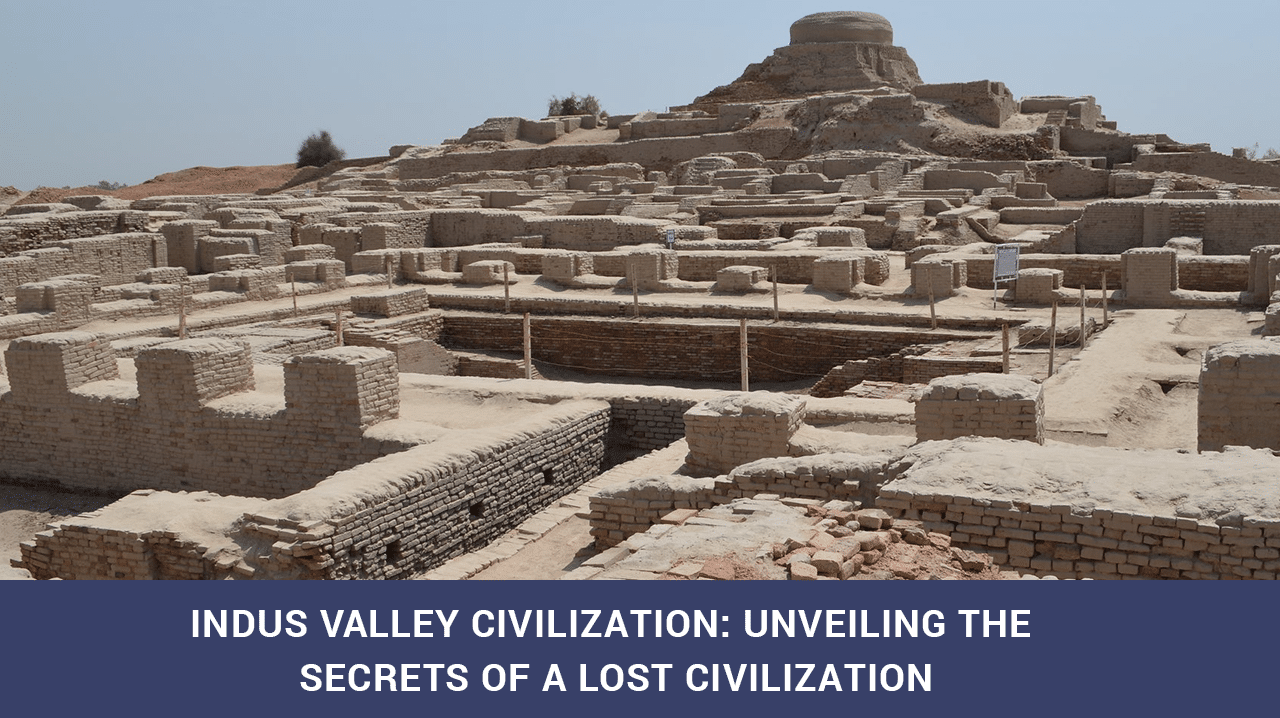Indus Valley Civilization: Unveiling the Secrets of a Lost Civilization

James Lewis, a restless soldier, quit the British East India Company’s army in 1827. He then set off on an expedition across the Indian landmass. After a couple of years, he found the remains of an old city in the Punjab area.
Not realizing its historical value back then, Lewis carefully noted his findings. He sketched the complex patterns and symbols he came across.
The mysteries surrounding the Indus Valley Civilization have long fascinated specialists, academics, and enthusiasts throughout the world.
For more than a millennium, between around 3300 and 1300 BCE, this remarkable civilization thrived on the fertile plains of what is now Pakistan and the northwest region of India.
The Rediscovery:
In the 1920s, nearly a century subsequent to Lewis’s original breakthrough, additional findings concerning the ancient civilization were brought to the forefront.
John Marshall, a famous Indian archaeologist also renowned director of the Archaeological Survey of India (ASI), did a lot of digging or excavations at Harappa’s ruins.
They found parts of a culture that is older than the Egyptian and Mesopotamian ones by over 5,000 years
Marshall’s discoveries were of immense importance for comprehending the Indus Valley Civilization, as they unveiled significant revelations regarding its abundant cultural heritage.
The Rise and Expansion of the Indus Valley Civilization:
Indus Valley Civilization’s rise to popularity marks an important turning point in human history.
It all started when farming communities spread across the rich Indus River plains. Between 7,000 BC and 5,500 BC, which we call the Pre-Harappan Phase, it really came alive
Soon, these small villages grew into big, busy cities that demonstrated remarkable advancements in infrastructure and urban development.
Mohenjo-Daro and Harappa, two thriving cities of the Harappan civilization, attest to the fact that urbanization was well-established by 2,600 BC.
Modern elements like multi-story brick homes, uniform brick dimensions, and an advanced drainage system that showcased the ingenuity of ancient engineers made these urban centers stand out.
Furthermore, the inclusion of public wells and meticulously planned urban layouts emphasized the advanced level of organization and forward-thinking displayed by the inhabitants of this remarkable civilization.
Urban Planning and Advanced Features:
The urban design of the Harappan cities serves as evidence of the impressive resourcefulness exhibited by the lost civilization residing in the Indus Valley.
The ancient cities possessed a meticulous design with intricate characteristics that demonstrated exceptional organizational skills and careful planning.
One of the notable advanced aspects was their efficient sanitation systems, encompassing well-constructed drainage systems to effectively handle waste and sewage management.
Additionally, the cities boasted tree-lined streets, public bathing areas, and even dustbins for waste disposal, indicating a keen focus on cleanliness and public health.
The attention to detail in the construction of these urban centers speaks volumes about the advanced capabilities of the lost civilization.
Overall, the urban planning and advanced features of the Harappan cities provide valuable insights into the social organization and technological prowess of the ancient Indus Valley Civilization
Language Yet to be Deciphered:
The Indus Script is the one unresolved riddle of the Indus Valley Civilization that has persisted over time.
With almost four hundred different symbols, this old writing system is still unsolvable.
Despite scholarly efforts, the lack of a bilingual inscription or a “Rosetta Stone” equivalent poses significant challenges to unraveling its meaning.
Although researchers have ascertained the script’s left-to-right orientation and detected specific patterns, a whole comprehension still eludes them.
A look into the variety of languages and cultures of the ancient society, the Indus Script encourages with its complexity.
Indus Script deciphering holds great promise for understanding the complex culture that flourished along the banks of the Indus River millennia ago, and academics are still working to solve this linguistic mystery.
Trade and Cultural Exchange:
Awesome archaeological discoveries show Mesopotamia, an old, rich culture and wealthy civilization located in today’s Iraq and Iran, had strong connections with the Indus Valley Civilization.
Indus Script seals and artifacts have been found on Mesopotamian sites, which indicates that a high degree of communication was made between these two ancient cultures.
Trade played a pivotal role in facilitating this exchange, with the Indus Valley Civilization offering sought-after resources like precious metals, gemstones, and agricultural produce to Mesopotamia in exchange for items such as timber, copper, and luxury goods.
The presence of dockyards and remnants of large ships further bolsters the hypothesis of extensive long-distance trade routes between the two regions.
The Decline and Disappearance:
People like archaeologists and scholars still wonder why the Indus Valley Civilization fell apart. Everyone was unaware of the true nature of this abrupt disappearance of a once-thriving society.
Instability in society, climate change, progressive cultural movements—as well as other theories—have all been put up, but nobody can agree on any of them.
There have been suggestions that environmental reasons like droughts, weather changes, societal problems, or cultural shifts.
It’s possible that the Ghaggar-Hakra River’s drying up caused agricultural failure and resource depletion since it supplied several Harappan towns with essential water supplies.
Evidence of large-scale flooding in some areas further indicates the vulnerability of the lost civilization to natural disasters.
Internal factors, including social and political instability, have also been theorized.
The absence of significant fortifications in Harappan cities and the lack of evidence for centralized political authority raise questions about the civilization’s governing structure.
Conflict, social unrest, or the collapse of trade networks could have contributed to its downfall.
Alternatively, some scholars propose that the Indus Valley Civilization experienced gradual cultural and economic changes rather than a sudden collapse.
They suggest that the civilization could not have completely vanished but rather might have altered and merged with neighboring societies, leaving a cultural imprint.
Whatever the precise explanation, the fall of the Indus Valley Civilization is still a fascinating and complicated subject that attracts interest from academics.
People who study history and culture remain interested in the Indus Valley Civilization. Why? Because it gives us knowledge about a time that was thousands of years ahead of us.
This civilization had advanced cities, impressive systems, and an interesting language.
Yes, there are still many things we don’t understand, but with ongoing digging and exploration, we hope to find out more.
By assembling historical pieces, we intend to acquire a deeper understanding. The civilization’s growing cities, unknown language, busy trading, and sudden disappearance all make it more interesting.
We are getting closer to understanding this amazing civilization’s legacy, which has made a lasting impression on human history as we uncover more mysteries.

